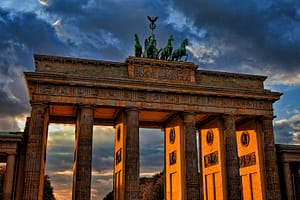MUSEUMS
Stasi Museum
Founded in 1990, this museum is the old Stasi headquarters, Germany’s former secret police. It is an essential outing for anyone hoping to understand just how life use to be in the DDR when Berlin was a divided city, and just how harsh life use to be. Today, the museum operates as a research and memorial centre concerning the political system of the former East Germany. It’s strongly recommended to tag along on one of the free guided tours that are given twice a day in both German and English. Without the tour and the special perspective and personal anecdotes of life under communism, it might be a bit like looking at old German boardrooms and furniture.
Museum für Naturkunde
If animal specimens, dinosaurs and meteorites are your thing, then the Museum für Naturkunde, Berlin’s museum of natural history is the place for you. Stimulate your imagination as science seeks to uncover the secrets of the universe, understand our own planet through a geology exhibition and be wowed be an enormous T-Rex. Located in Berlin’s famous ‘Museum Island’ quarter in Mitte where many of the greats can be found, it’s a great day for children and adults alike, while the building of the museum is also a beautiful attraction.
Deutsches Technikmuseum Berlin
Another one for inquiring minds, this is for those who like to tinker and learn about how stuff works, or rather how stuff could work in the future. The German Museum of Technology Berlin has an extensive collection of planes, boats, trains and cameras, that all pay tribute to the amazing German engineering over the decades, for which the country is so famous for. There is so much to see here – from the early steam locomotives to rail cars and an entire section on aviation – that it would be wise to book out the whole day to fully explore all it has to offer.
Neues Museum
This is Berlin’s museum of Ancient Egypt and is overflowing with magnificent Egyptian art and artefacts. The basement floor is taken up by the large sarcophaguses and Egyptian tomb walls and sophisticated hieroglyphics. The crowning feature of the museum is by far the bust of Nefertiti, the 1300 BC Egyptian Queen. The building, which was in ruin after the war, has been rebuilt by architect David Chipperfield and is an amazing artefact in itself.
Topography of Terror
The Topography of Terror is a document of Nazi atrocities. It is also an example of how Germany has taken responsibility for its history, by actively submitting itself to national psychoanalysis. Germany brings its dark past into light with this free, outdoor museum, built on the site of the former headquarters of the SS and Gestapo. A heartbreaking and necessary experience.
Bauhaus-Archiv Museum
Berlin is the home of Bauhaus, the immortal school of architecture, design and art founded by Walter Gropius. A must-see for architects and design junkies, Bauhaus is the most influential school of fine art and craft practises the 20th century has ever seen. The archive houses an incredible collection of sculptures, ceramics, furniture and architectural models by Walter Gropius, Moholy-Nagy, Klee, Kandinsky and many others. Heads up – the museum is closed on Tuesdays.
Pergamon
The Pergamon in the home of ancient Greek and Roman art collections, as well as a fascinating collection of Babylonian and Persian antiquities. Enjoy treasures from the ancient world displayed in a remarkable way over two floors. The Museum of Islamic Art upstairs is also full of beautiful pieces of art hailing from the eastern world.
Käthe Kollwitz Museum
Established in 1986, this museum houses the largest collection of work by German artist Käthe Kollwitz. The artist lived and worked in Berlin’s Prenzlauer Berg for over 50 years, and her intimate works captured the suffering of its residents and the lives of the poor – their hopes and horrors. This privately owned museum, just off the Ku’damm, has hundreds of her finest drawings, etchings and sculptures for the public to marvel over.
Museum Berggruen
Museum Berggruen is situated in from of Schloss Charlottenburg, where inside some masterpieces of modern art await. The museum takes its name from Heinz Berggruen who bought his first painting, a watercolour by Paul Klee, in 1940. Half a century later, he gave the city most of his special collection, which was valued at around $450 million. Berggruen houses paintings by some of the greats, like Picasso, Klee, Condo and Matisse.
Museum für Fotografie
Set in a neoclassical building that used to be a casino for army officers, the Museum of Photography, which can also be included on your trip to Charlottenburg, houses pictures from the 19th century to the present, and will make any photography lover gawk. The museum has a permanent exhibition of Helmut Newton‘s famous nudes. Newton is one of the most important fashion and portrait photographers of the 20th century, and loaned a large part of his personal collection for an exhibition to the public.
MARKETS
Flea markets
A Sunday in the capital wouldn’t be complete without a wander around one of its many flea markets and they are the perfect place to find relatively cheap items that no one else will have.
The market at Mauerpark is the largest and most famous of them all with antiques, clothing, art and food as well as karaoke in the amphitheatre nearby. But be warned, it is also the most expensive as it tends to attract more tourists than hardcore bargain hunters.
There are dozens of other weekly flea markets around Berlin, many of which are open all year round including Arkonaplatz (pictured above), the antique market at Ostbahnhof. The Nowkoelln Flowmarkt and Kreuzboerg Flowmarkt (yes, that is actually how they are spelled) are also great places to find second hand clothes and handmade items but the markets are closed during the winter months.

